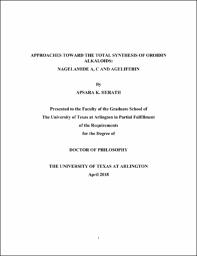
ATTENTION: The works hosted here are being migrated to a new repository that will consolidate resources, improve discoverability, and better show UTA's research impact on the global community. We will update authors as the migration progresses. Please see MavMatrix for more information.
Show simple item record
| dc.contributor.advisor | Lovely, Carl | |
| dc.creator | Herath, Apsara | |
| dc.date.accessioned | 2020-06-23T20:57:41Z | |
| dc.date.available | 2020-06-23T20:57:41Z | |
| dc.date.created | 2018-05 | |
| dc.date.issued | 2018-05-25 | |
| dc.date.submitted | May 2018 | |
| dc.identifier.uri | http://hdl.handle.net/10106/29159 | |
| dc.description.abstract | Nagelamides and ageliferin are oroidin-derived alkaloids which have gained the attention of the scientific community, because of their significant biological activity as well as the unprecedented structural diversity. Our work is directed toward the development of synthetic methods for the construction of oroidin dimers. Accordingly, this dissertation is composed of two sections; the chapter one provides an overview of the oroidin alkaloids with a particular focus on the nagelamide family and the third chapter describes synthetic studies towards ageliferin.
The first part of chapter two focuses on the Palladium-catalyzed Stille cross-coupling reaction for the construction of the main dimeric scaffolds of the nagelamide molecules. First, we describe new methodology to synthesize the iodoimidazole fragment for use in the Stille cross-coupling reaction and subsequent progress in optimizing the yield of Stille reaction. Additional advancement of the synthesis has been achieved via azide installation in allylic and alkyl side chains of the basic framework of nagelamides A and C. A convenient method of dimethylaminosulfonyl group deprotection was reported on these advanced intermediates prior to the installation of pyrrole carboxamide moieties.
The second part of chapter two details a novel approach for acylation was developed in azide-containing imidazole systems using thio acid chemistry providing amides in one step. The reaction conditions were optimized in diverse monomeric imidazole containing-azide systems, and excellent yields of acetamide and benzamide formation were obtained. Interestingly, a newly synthesized pyrrole thio acid offers promising results for the installation of the pyrrole carboxamide moiety in oroidin-derived systems. This chemistry can be employed in the final transformation of nagelamide A and C to install the pyrrole carboxamide moieties, however; the final reaction conditions still require optimization.
The third chapter describes a potential intermediate en route to ageliferin which was constructed through an intramolecular Diels-Alder reaction using 4-vinylimidazole tethered to a urazole as the starting material. The Diels-Alder precursor was synthesized through palladium-catalyzed Tsuji-Trost cross-coupling reaction between t-butyl carbonate protected vinylimidazole and N-phenylurazole in excellent yield.
We have explored three different protecting groups (DMAS, Bn, and SEM) on the imidazole nitrogen which can affect both the Diels-Alder reactivity and the electronic nature of the tetrahydrobenzimidazole ring system. For example, this can influence the oxidative rearrangement and introduction of the C2-amino moiety at the later in the synthesis. Further studies are in progress to complete the total synthesis of ageliferin using these advanced intermediates. | |
| dc.format.mimetype | application/pdf | |
| dc.language.iso | en_US | |
| dc.subject | Nagelamides | |
| dc.subject | Ageliferin | |
| dc.title | Approaches Toward the Total Synthesis of Oroidin Alkaloids:Nagelamide A, C and Ageliferin | |
| dc.type | Thesis | |
| dc.degree.department | Chemistry and Biochemistry | |
| dc.degree.name | Doctor of Philosophy in Chemistry | |
| dc.date.updated | 2020-06-23T20:57:42Z | |
| thesis.degree.department | Chemistry and Biochemistry | |
| thesis.degree.grantor | The University of Texas at Arlington | |
| thesis.degree.level | Doctoral | |
| thesis.degree.name | Doctor of Philosophy in Chemistry | |
| dc.type.material | text | |
Files in this item
- Name:
- HERATH-DISSERTATION-2018.pdf
- Size:
- 2.637Mb
- Format:
- PDF
This item appears in the following Collection(s)
Show simple item record


